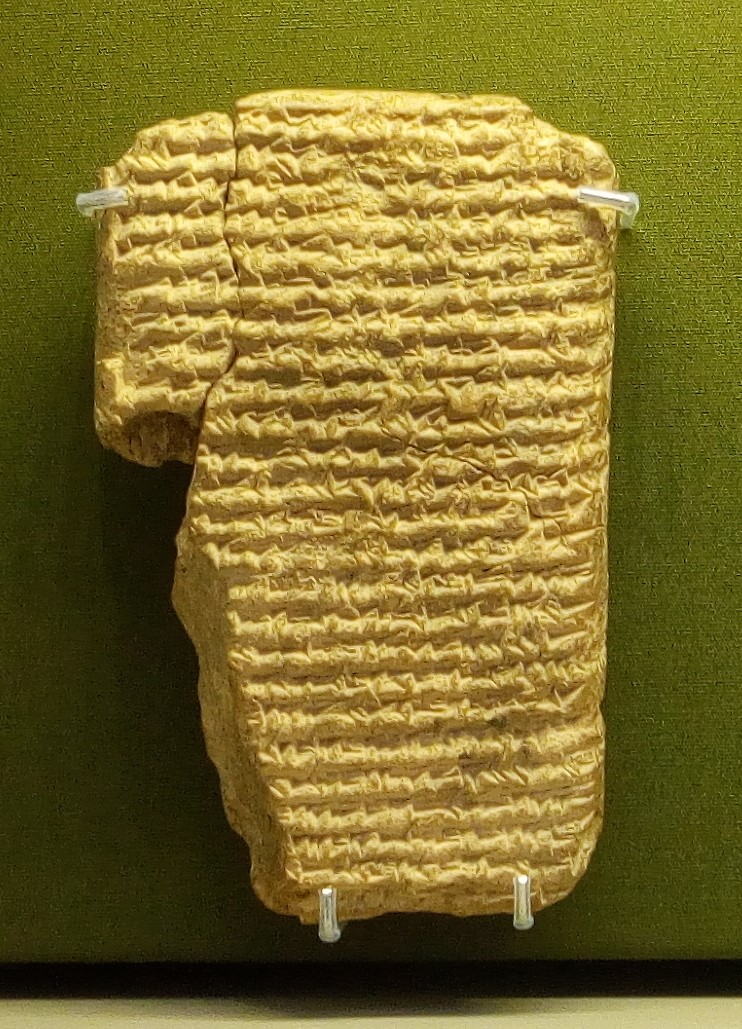|
Aššur-etil-ilāni
Aššur-etil-ilāni, also spelled Ashur-etel-ilani' and Ashuretillilani (, meaning " Ashur is the lord of the Tree"),' was the king of the Neo-Assyrian Empire from 631 BC to 627 BC. Aššur-etil-ilāni is an obscure figure with a brief reign from which few inscriptions survive. Because of this lack of sources, very little concrete information about the king and his reign can be deduced. It is possible that Aššur-etil-ilāni was a weak ruler as there are no records of the king ever undertaking a military campaign or going on a hunt, activities previous Assyrian kings would famously do very often; this, in turn, may have helped to entice some of Assyria's vassals, such as the Kingdom of Judah, to break free from Assyrian control and begin to act independently. Aššur-etil-ilāni was succeeded by his brother Sîn-šar-iškun under uncertain, though not necessarily violent, circumstances. Background and chronology There is a distinct lack of available sources in regards to the ... [...More Info...] [...Related Items...] OR: [Wikipedia] [Google] [Baidu] |
Sîn-šumu-līšir
Sîn-šumu-līšir or Sîn-šumu-lēšir' ( or , meaning " Sîn, make the name prosper!"), also spelled Sin-shum-lishir,' was a usurper king in the Neo-Assyrian Empire, ruling some cities in northern Babylonia for three months in 626 BC during a revolt against the rule of the king Sîn-šar-iškun. He was the only eunuch to ever claim the throne of Assyria. Nothing is known of Sîn-šumu-līšir's background or family and he first appears as a prominent courtier and general in the reign of Aššur-etil-ilāni (631–627 BC). After the death of Aššur-etil-ilāni's father and predecessor Ashurbanipal (669–631 BC), Sîn-šumu-līšir was instrumental in securing Aššur-etil-ilāni's rise to the throne and consolidating his position as king by defeating attempted revolts against his rule. It is possible that Sîn-šumu-līšir, as a prominent general close to the king, was the ''de facto'' ruler of Assyria throughout Aššur-etil-ilāni's reign. Aššur-etil-ilāni died in 627 ... [...More Info...] [...Related Items...] OR: [Wikipedia] [Google] [Baidu] |
Sîn-šar-iškun
Sîn-šar-iškun ( or , meaning "Sin (mythology), Sîn has established the king")' was the penultimate king of Assyria, reigning from the death of his brother and predecessor Aššur-etil-ilāni in 627 BC to his own death at the Fall of Nineveh in 612 BC. Succeeding his brother in uncertain, but not necessarily violent circumstances, Sîn-šar-iškun was immediately faced by the revolt of one of his brother's chief generals, Sîn-šumu-līšir, who attempted to usurp the throne for himself. Though Sîn-šumu-līšir was defeated relatively quickly, the instability caused by his revolt, combined with an ongoing interregnum in Babylonia in the south (neither Sîn-šar-iškun nor Sîn-šumu-līšir had formally proclaimed themselves as kings of Babylon) might be what made it possible for Nabopolassar, a southerner of unclear origin, to rise up and seize power in Babylonia. Sîn-šar-iškun's inability to defeat Nabopolassar, despite repeated attempts over the course of several year ... [...More Info...] [...Related Items...] OR: [Wikipedia] [Google] [Baidu] |
Ana-Tašmētum-taklāk
Ana-Tašmētum-taklāk ( Akkadian: ''Ana-Tašmētum-taklāk'' or ''Ana-Tašmētu-taklak'')' was a queen of the Neo-Assyrian Empire. She is known only from a single fragmentary inscription and it has as of yet not been possible to confidently identify which king was her husband. She is the only Neo-Assyrian queen known by name whose husband and dates are unknown. Though various identifications have been proposed, the hypothesis with the least problems is that she was the wife of one of the last Assyrian kings, Aššur-etil-ilāni (631–627 BC) or Sîn-šar-iškun (627–612 BC). Inscription Ana-Tašmētum-taklāk is known only from an inscription on a burnt limestone vessel from either Nineveh or the nearby Tarbisu. An origin in Nineveh is more probable. The vessel, given the designation 55-12-5, 252, in the British Museum, is a shallow dish made for some specific, though unknown, purpose. The inscription runs around the top, on the flat edge of the rim. It is unclear ... [...More Info...] [...Related Items...] OR: [Wikipedia] [Google] [Baidu] |
List Of Assyrian Kings
The king of Assyria (Akkadian language, Akkadian: , later ) was the ruler of the ancient Mesopotamian kingdom of Assyria, which was founded in the late 21st century BC and fell in the late 7th century BC. For much of its early history, Assyria was little more than a city-state, centered on the city Assur, but from the 14th century BC onwards, Assyria rose under a series of warrior kings to become one of the major political powers of the Ancient Near East, and in its last few centuries it dominated the region as the largest empire the world had seen thus far. Ancient Assyrian history is typically divided into the Old Assyrian Empire, Old, Middle Assyrian Empire, Middle and Neo-Assyrian Empire, Neo-Assyrian periods, all marked by ages of ascendancy and decline. The ancient Assyrians did not believe that their king was divine himself, but saw their ruler as the vicar of their principal deity, Ashur (god), Ashur, and as his chief representative on Earth. In their worldview, Assyria rep ... [...More Info...] [...Related Items...] OR: [Wikipedia] [Google] [Baidu] |
Ashurbanipal
Ashurbanipal (, meaning " Ashur is the creator of the heir")—or Osnappar ()—was the king of the Neo-Assyrian Empire from 669 BC to his death in 631. He is generally remembered as the last great king of Assyria. Ashurbanipal inherited the throne as the favored heir of his father Esarhaddon; his 38-year reign was among the longest of any Assyrian king. Though sometimes regarded as the apogee of ancient Assyria, his reign also marked the last time Assyrian armies waged war throughout the ancient Near East and the beginning of the end of Assyrian dominion over the region. Esarhaddon selected Ashurbanipal as heir 673. The selection of Ashurbanipal bypassed the elder son Shamash-shum-ukin. Perhaps in order to avoid future rivalry, Esarhaddon designated Shamash-shum-ukin as the heir to Babylonia. The two brothers jointly acceded to their respective thrones after Esarhaddon's death in 669, though Shamash-shum-ukin was relegated to being Ashurbanipal's closely monitored vassal. Mu ... [...More Info...] [...Related Items...] OR: [Wikipedia] [Google] [Baidu] |
Libbāli-šarrat
Libbāli-šarrat (Akkadian language, Akkadian: ''Libbāli-šarrat'', meaning "the inner city [=Ishtar?] is queen") was a queen of the Neo-Assyrian Empire as the primary consort of Ashurbanipal (669–631 BC). Libbāli-šarrat married Ashurbanipal before he became king, probably in 672 BC, and may have lived beyond her husband's death, as documents from the reign of her probable son, Ashur-etil-ilani (631–627 BC) reference the "mother of the king". Libbāli-šarrat enjoys the distinction of being the only known individual from ancient Assyria who was not a king to be depicted holding court since she is depicted in one of Ashurbanipal's reliefs as hosting him at dinner in the palace garden, surrounded by her own female servants. Life Wife of the crown prince It is not clear when Libbāli-šarrat married Ashurbanipal. The queen of Ashurbanipal's father Esarhaddon (681–669 BC), Ešarra-ḫammat, died in February 672 BC. Contemporary documents recording Ešarra-ḫammat's fune ... [...More Info...] [...Related Items...] OR: [Wikipedia] [Google] [Baidu] |
World History Encyclopedia
World History Encyclopedia (formerly Ancient History Encyclopedia) is a nonprofit educational company created in 2009 by Jan van der Crabben. The organization publishes and maintains articles, images, videos, podcasts, and interactive educational tools related to history. All users may contribute content to the site, although submissions are reviewed by an editorial team before publication. In 2021, the organization was renamed from the Ancient History Encyclopedia to World History Encyclopedia to reflect its broadened scope, covering world history from all time periods, as opposed to just ancient history. Original articles are written in English and later translated into other languages, mainly French and Spanish. Organization history The Ancient History Encyclopedia was founded in 2009 by van der Crabben with the stated goal of improving history education worldwide by creating a freely accessible and reliable history source. The nonprofit organization is based in Godalming, Unit ... [...More Info...] [...Related Items...] OR: [Wikipedia] [Google] [Baidu] |
Esarhaddon
Esarhaddon, also spelled Essarhaddon, Assarhaddon and Ashurhaddon (, also , meaning " Ashur has given me a brother"; Biblical Hebrew: ''ʾĒsar-Ḥaddōn'') was the king of the Neo-Assyrian Empire from 681 to 669 BC. The third king of the Sargonid dynasty, Esarhaddon is most famous for his conquest of Egypt in 671 BC, which made his empire the largest the world had ever seen, and for his reconstruction of Babylon, which had been destroyed by his father. After Sennacherib's eldest son and heir Aššur-nādin-šumi had been captured and presumably executed in 694, the new heir had originally been the second eldest son, Arda-Mulissu, but in 684, Esarhaddon, a younger son, was appointed instead. Angered by this decision, Arda-Mulissu and another brother, Nabû-šarru-uṣur, murdered their father in 681 and planned to seize the Neo-Assyrian throne. The murder, and Arda-Mulissu's aspirations of becoming king himself, made Esarhaddon's rise to the throne difficult and he first ... [...More Info...] [...Related Items...] OR: [Wikipedia] [Google] [Baidu] |
Babylonia
Babylonia (; , ) was an Ancient history, ancient Akkadian language, Akkadian-speaking state and cultural area based in the city of Babylon in central-southern Mesopotamia (present-day Iraq and parts of Kuwait, Syria and Iran). It emerged as an Akkadian-populated but Amorites, Amorite-ruled state . During the reign of Hammurabi and afterwards, Babylonia was retrospectively called "the country of Akkad" ( in Akkadian), a deliberate archaism in reference to the previous glory of the Akkadian Empire. It was often involved in rivalry with the older ethno-linguistically related state of Assyria in the north of Mesopotamia and Elam to the east in Ancient Iran. Babylonia briefly became the major power in the region after Hammurabi (floruit, fl. –1752 BC middle chronology, or –1654 BC, short chronology timeline, short chronology) created a short-lived empire, succeeding the earlier Akkadian Empire, Third Dynasty of Ur, and Old Assyrian Empire. The Babylonian Empire rapidly fell apar ... [...More Info...] [...Related Items...] OR: [Wikipedia] [Google] [Baidu] |
Ashdod
Ashdod (, ; , , or ; Philistine language, Philistine: , romanized: *''ʾašdūd'') is the List of Israeli cities, sixth-largest city in Israel. Located in the country's Southern District (Israel), Southern District, it lies on the Mediterranean Sea, Mediterranean Israeli coastal plain, coast south of Tel Aviv and north of Ashkelon. Port of Ashdod, Ashdod's port is the largest in Israel, handling 60% of the country's imported goods. Modern Ashdod was established in 1956 on the sand hills 6 kilometers northwest of the Ashdod (ancient city), ancient city of Ashdod, known in modern times by its Arabic name Isdud. Isdud had been depopulated during the 1948 Arab–Israeli War, having had a history spanning approximately 3,700 years. In ancient times, ancient Ashdod developed as an active maritime trade center, with its ports identified at Ashdod-Yam and Tel Mor. In History of ancient Israel and Judah, biblical times, it was one of the five principal cities of the Philistines. Ashdod ... [...More Info...] [...Related Items...] OR: [Wikipedia] [Google] [Baidu] |
Levant
The Levant ( ) is the subregion that borders the Eastern Mediterranean, Eastern Mediterranean sea to the west, and forms the core of West Asia and the political term, Middle East, ''Middle East''. In its narrowest sense, which is in use today in archaeology and other cultural contexts, it is equivalent to Cyprus and a stretch of land bordering the Mediterranean Sea in Western AsiaGasiorowski, Mark (2016). ''The Government and Politics of the Middle East and North Africa''. p. 5: "... today the term ''Levantine'' can describe shared cultural products, such as Levantine cuisine or Levantine archaeology". .Steiner & Killebrew, p9: "The general limits ..., as defined here, begin at the Plain of 'Amuq in the north and extend south until the Wâdī al-Arish, along the northern coast of Sinai. ... The western coastline and the eastern deserts set the boundaries for the Levant ... The Euphrates and the area around Jebel el-Bishrī mark the eastern boundary of the northern Levant, as d ... [...More Info...] [...Related Items...] OR: [Wikipedia] [Google] [Baidu] |







